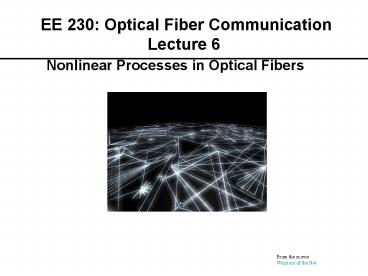EE 230: Optical Fiber Communication Lecture 6 PowerPoint PPT Presentation
1 / 32
Title: EE 230: Optical Fiber Communication Lecture 6
1
EE 230 Optical Fiber Communication Lecture 6
Nonlinear Processes in Optical Fibers
From the movie Warriors of the Net
2
Polarization
- In molecules, PµaEßE2?E3
- In materials, PX(o)X(1)EX(2)E2X(3)E3
- If multiple electric fields are applied, every
possible cross term is generated. - At sufficiently high values of E, quadratic or
higher terms become important and nonlinear
effects are induced in the fiber.
3
Polarization
Distortion of an electron cloud in response to an
E-field
Molecules and their dipole moments
4
Non-linear Polarization
5
Nonlinear Effects
- Stimulated Raman scattering
- Stimulated Brillouin scattering
- Four-wave Mixing
- Self-phase Modulation
- Cross-phase Modulation
6
Index of Refraction
7
Imaginary part of index absorption
- For a sample of absorbance A and thickness d, the
imaginary part of the refractive index is equal
to
8
Index of Refraction vs Wavelength
Refractive Index for various materials
Refractive index vs Frequency for silica
Wave slowing in a medium of higher Index
9
Nonlinear index of refraction
- Real part of index is best described as a power
series - nn1n2(P/Aeff)
- Term in parentheses is the intensity. For silica
fiber, n2?2.6x10-11 µm2/mW
10
Interaction Length
- where a (in cm-1) is the loss coefficient of the
fiber. 0.1 dB/km2.3x10-7 cm-1.
11
Nonlinear parameter
- Propagation constant is power-dependent
12
Propagation in Single Mode Fiber
Geometrical optics is not useful for single mode
fiber, must be handled by full E M
treatment Think of guiding as diffraction
constrained by refraction Fields are
evanescently damped in the cladding
Understanding Fiber Optics-Hecht
13
Effective Length and effective area
14
Single Mode Gaussian Approximation
Fundamentals of Photonics - Saleh and Teich
Fiber Optic Communiocation Systems - Agrawal
15
Gaussian Pulse Mode Field Diameter
Fiber Optics Communication Technology-Mynbaev
Scheiner
16
Mitigation
- If P is high in a fiber application, the
nonlinear component of the index is minimized by
increasing the effective area of the fiber.
Fiber designed for this purpose is called LEAF
fiber (Large Effective Area).
17
Phase modulation
- Self-modulation fNL ?PLeff
- Cross-modulation fNL 2?PotherLeff
- Effect of these phase changes is a frequency
chirp (frequency changes during pulse),
broadening pulse and reducing bit rate-length
product
18
Self Phase Modulation
19
Pulse Spreading due to Self Phase Modulation
20
Gaussian Pulse in a Kerr Medium
Phase change of gaussian pulse
Instantaneous frequency shift
Instantaneous Frequency chirp
21
Solitons
22
Nonlinear scattering
- Signal photon scatters off oscillation that is
present in the material, gains or loses frequency
equivalent to that of the material oscillation - At high powers, beating of signal frequency and
scattered frequency generates frequency component
at the difference that drives the material
oscillations
23
Stimulated Brillouin Scattering
- Sound waves represent alternating regions of
compressed material and expanded material - Index of refraction increases with density of
polarizable electrons and thus with compression - Scattering is induced by index discontinuities
24
SBS, continued
- Transfer of energy into acoustic wave results in
backwards scattering in fiber - Brillouin frequency shift equal to 2nv/?, where n
is the mode index and v is the speed of sound in
the material - For fiber, scattered light is 11 GHz lower in
frequency than signal wavelength (speed of sound
is 5.96 km/s)
25
Stimulated Raman scattering
- Oscillations are Si-O bonds in the glass,
frequency 3.3x1013 Hz - Scattered photon can come off decreased by that
amount (Stokes) or increased by that amount
(anti-Stokes) - Stokes shift scatters 1550 nm light up to 1870 nm
light
26
Raman shift in silica
- Spectrum shows major peaks at 1100, 800, and 450
cm-1 - Those vibrational oscillations occur at 33, 24,
and 13.5 THz - Raman gain spectrum shows maximum at 12-14, 18,
24, and 33 THz
27
Four-wave Mixing
28
Taylor Series expansion of ß(?)
- Through the cubic term
- where
29
Importance of Taylor Series terms
- Group velocity Vg, dispersion D, and dispersion
slope S
30
Four-Wave Mixing Phase-Matching Requirement
- Phase mismatch M needs to be small for FWM to
occur significantly
31
FWM in a WDM system
- ?1?2? (power lost from one signal wavelength)
- ?3?? where ? is the difference in frequency
between adjacent channels - ?4?-?
- Substitute in phase mismatch expression to get
Mß2?2 - Want ß2 to be big to minimize FWM!
32
Four Wave Mixing

